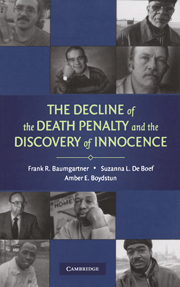Book contents
- Frontmatter
- Contents
- List of Tables
- List of Figures
- Acknowledgments
- 1 Innocence and the Death Penalty Debate
- 2 The Death Penalty in America
- 3 A Chronology of Innocence
- 4 The Shifting Terms of Debate
- 5 Innocence, Resonance, and Old Arguments Made New Again
- 6 Public Opinion
- 7 The Rise and Fall of a Public Policy
- 8 Conclusion
- Epilogue: Individuals Exonerated from Death Row
- Appendix A New York Times capital punishment coverage, 1960 to 2005
- Appendix B Description of Data
- Notes
- References
- Index
1 - Innocence and the Death Penalty Debate
Published online by Cambridge University Press: 05 September 2012
- Frontmatter
- Contents
- List of Tables
- List of Figures
- Acknowledgments
- 1 Innocence and the Death Penalty Debate
- 2 The Death Penalty in America
- 3 A Chronology of Innocence
- 4 The Shifting Terms of Debate
- 5 Innocence, Resonance, and Old Arguments Made New Again
- 6 Public Opinion
- 7 The Rise and Fall of a Public Policy
- 8 Conclusion
- Epilogue: Individuals Exonerated from Death Row
- Appendix A New York Times capital punishment coverage, 1960 to 2005
- Appendix B Description of Data
- Notes
- References
- Index
Summary
On july 25, 1984, nine-year-old Dawn Hamilton went to play in the woods near her aunt's home in the Baltimore suburb of Rosedale, Maryland. When Dawn did not return, her aunt called the police. Several hours later, searchers found Dawn's body in the woods beaten, raped, and strangled. Her underwear was found hanging in a tree, and a bloody rock was found near the little girl's crushed head – a gruesome and horrifying scene.
At the time, former marine Kirk Noble Bloodsworth, twenty-three, was living in Baltimore County. He had no criminal background, but fit the description of the man who two boys, ages seven and ten, said they had seen entering the woods with Dawn that day. Police arrested Bloodsworth. The principal evidence linking him to the crime was testimony by five government witnesses (including the two boys) who identified Bloodsworth as the man they had seen with Dawn soon before she disappeared. This eyewitness testimony contradicted testimony by Bloodsworth's friends that he had been at home at the time of the incident. There was no physical evidence linking Bloodsworth to the crime, but prosecutors suggested that a shoe print left near the girl's body was the same size as a pair of Bloodsworth's shoes. Prosecutors also aggressively questioned the credibility of the defense witnesses. After serving in the marines, Bloodsworth had been unemployed and spent time partying, drinking, and associating with a shifting group of friends who did not make strong character or alibi witnesses.
- Type
- Chapter
- Information
- Publisher: Cambridge University PressPrint publication year: 2008
- 1
- Cited by



